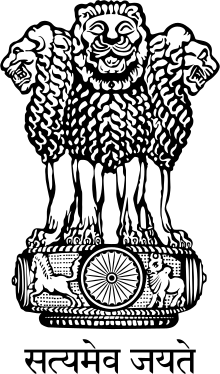Indian Police Service
The Indian Police Service (IPS) is one of the three All India Services as envisaged in the Constitution of India.[3] It replaced the Indian Imperial Police in 1948, a year after India became independent from the United Kingdom.
| Service Overview | |
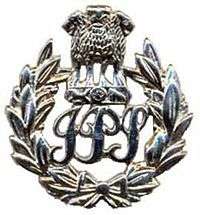 | |
| Formerly known as | Imperial Police[1] |
|---|---|
| Abbreviation | IPS |
| Date of Establishment | 1905 (As Imperial Police) 1948 (as IPS)[1] |
| Country | India |
| Staff College | Sardar Vallabhbhai Patel National Police Academy, Hyderabad, Telangana |
| Cadre Controlling Authority | Ministry of Home Affairs, Government of India |
| Minister Responsible | Amit Shah, Ministry of Home Affairs and the home ministry of the state they are posted in. |
| Legal personality | Governmental: Government service |
| Duties | Law Enforcement Crime Investigation Security Intelligence (Internal & External) Public Order |
| Cadre Strength | 3894 members (2016)[2] |
| Selection | Civil Services Examination |
| Association | IPS (Central) Association |
| Head of All India Services | |
| Cabinet Secretary | Rajiv Gauba, IAS |
Along with the Indian Administrative Service (IAS) and the Indian Forest Service (IFS), the IPS is one of the three All India Services[3] — its officers can be employed by both the Union Government and the individual states.
The service was envisaged to command and provide leadership to state police forces and the union territories and also Central Armed Police Forces (BSF, SSB, CRPF, CISF, & ITBP) and Central Police Organisations. IPS officers played a key role in formation of Central armed Police Forces and their subsequent growth. The supreme Court has clarified in its order that grant of NFFU to CAPFs doesn't impact rights of IPS officers, if any regarding deputations to CAPFs[4] The Bureau of Police Research and Development (BPR&D) is responsible for research and development of the police force in India.
History
There is no alternative to this administrative system... The Union will go, you will not have a united India if you do not have good All-India Service which has the independence to speak out its mind, which has sense of security that you will standby your work... If you do not adopt this course, then do not follow the present Constitution. Substitute something else... these people are the instrument. Remove them and I see nothing, but a picture of chaos all over the country.
— Sardar Vallabhbhai Patel in Constituent Assembly discussing the role of All India Services[5][6][7]
British India



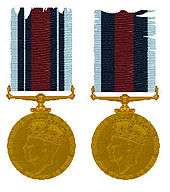
In 1861, the British Government introduced the Indian Councils Act, 1861.[8] The act created the foundation of a modern and professionalised police bureaucracy in India. It introduced, a new cadre of police, called Superior Police Services, later known as the Indian Imperial Police.[8] The highest rank in the service was the inspector general[8] for each province. The rank of inspector general was equated and ranked with brigadier,[9] and similar ranks in the Indian Armed Forces, as per central warrant of precedence in 1937.[lower-alpha 1][9]
In 1902–03, a police commission was established for the Police reforms under Sir Andrew Fraser and Lord Curzon.[10] It recommended the appointment of Indians at officer level in the police. Indians could rise only to the ranks of Inspector of police, the senior N.C.O. position. However they were not part of Indian Imperial Police.[10]
From 1920, Indian Imperial Police was open to Indians and the entrance examination for the service was conducted both in India and England.[10]
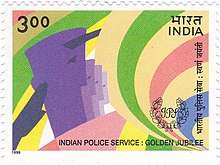
Prior to Independence, senior police officers belonging to the Imperial Police (IP) were appointed by the secretary of state on the basis of a competitive examination. The first open civil service examination for admission to the service was held in England in June 1893 and the ten top candidates were appointed as probationers in the Indian (Imperial) Police. It is not possible to pinpoint an exact date on which the Indian Police came formally into being. Around 1907, the secretary of state's officers were directed to wear the letters "IP" on their epaulettes in order to distinguish them from the other officers not recruited by the secretary of state through examination. In this sense, 1907 could be regarded as the starting point.[1] In 1948, a year after India gained independence; the Imperial Police was replaced by IPS.
Modern India
The modern Indian Police Service was created under the Article 312(2) in part XIV of the Constitution of India.[11]
As per media reports, there is a massive shortage of IPS officers in India, amounting to nearly 19% to 22% of sanctioned strength.[12][13]
Medals and decorations
Despite being a very small cadre strength many IPS officers have been awarded highest gallantry awards ( Ashok Chakra, Kirti Chakra ). The present National Security Advisor, India who was an IPS officer was awarded Kirti Chakra for his gallant actions during operation Blue Star. Though generally deployed in supervisory capacity at senior levels it's not uncommon for even a three star general rank IPS officers to be seen on the road taking active part in law and order maintenance. IPS officers have been posted to various UN Missions have been awarded United Nations Medal. Many exceptional IPS officers have been awarded with Padma awards from time to time.
Objective
The First Police Commission, appointed on 17 August 1865, contained detailed guidelines for the desired system of police in India and defined the police as a governmental department to maintain order, enforce the law, and to prevent and detect crime. The Indian Police Service is not a force itself but a service providing leaders and commanders to staff the state police and all-India Central Armed Police Forces. Its members are the senior officers of the police. With the passage of time Indian Police Service's objectives were updated and redefined, the current roles and functions of an Indian Police Service Officer are as follows:[14]
- To fulfil duties based on border responsibilities, in the areas of maintenance of public peace and order, crime prevention, investigation, and detection, collection of intelligence, VIP security, counter-terrorism, border policing, railway policing, tackling smuggling, drug trafficking, economic offences, corruption in public life, disaster management, enforcement of socio-economic legislation, bio-diversity and protection of environmental laws etc.
- Leading and commanding the Indian Intelligence Agencies like Research and Analysis Wing (R&AW), Intelligence Bureau (IB), Central Bureau of Investigation (CBI), Criminal Investigation Department (CID) etc., Indian Federal Law Enforcement Agencies, Civil and Armed Police Forces in all the states and union territories.
- Leading and commanding various Central Armed Police Forces (CAPF) which include the Central Police Organisations (CPO) such as Border Security Force (BSF), Central Reserve Police Force (CRPF), Indo-Tibetan Border Police (ITBP), National Security Guard (NSG), Central Industrial Security Force (CISF), Vigilance Organisations and Indian Federal Law Enforcement Agencies.
- To lead and command the force with courage, uprightness, dedication and a strong sense of service to the people.
- Endeavor to inculcate in the police forces under their command such values and norms as would help them serve the people better.
- Inculcate integrity of the highest order, sensitivity to aspirations of people in a fast-changing social and economic milieu, respect for human rights, broad liberal perspective of law and justice and high standard of professionalism.
Selection
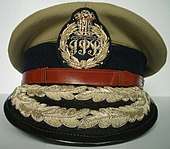
IPS officers are recruited from Civil Services Examination conducted by UPSC. They are also promoted from State Police Services and DANIPS. However, at present, recruitment from Limited Competitive Examination has been put on hold.[12]
Training
The training of IPS officer recruits is conducted at Sardar Vallabhbhai Patel National Police Academy in Hyderabad. The authorised cadre strength of Indian Police Service is 4920. (3270 Direct Recruitment Posts and 1650 Promotional Posts).[15] The Civil List of IPS officers is an updated (annual) list maintained by the Ministry of Home Affairs, Government of India that lists the posting details of all IPS officers in India. This Civil List can be accessed from the MHA website. It allows searching for an IPS officer on the basis of his/her name, Batch or Cadre.[16]
State cadres
Cadre allocation policy
The Union Government announced a new cadre allocation policy for the All India Services in August 2017, touting it as a policy to ensure national integration of the bureaucracy as officers and ensure All-India character of the services. Under the new policy, the existing 26 cadres have been divided into five zones in the new policy by the Department of Personnel and Training of Government of India.[17][18][19][20][21][22][23]
Under the new policy, a candidate has to first give his/her choice in the descending order of preference from amongst the various Zones.[23] Subsequently, the candidate has to indicate one preference of cadre from each preferred zone.[23] The candidate indicates his second cadre preference for every preferred zone subsequently. The process continues till a preference for all the cadres is indicated by the candidate.[23] The preference for the zones/cadres remains in the same order and no change is permitted.[23]
Officers continue to work in the cadre they are allotted or are deputed to the Government of India.[24]
| Zone | Cadres |
|---|---|
| Zone-I | AGMUT (Arunachal Pradesh-Goa-Mizoram and Union Territories, Jammu and Kashmir, Ladakh), Himachal Pradesh, Uttarakhand, Punjab, Rajasthan and Haryana. |
| Zone-II | Uttar Pradesh, Bihar, Jharkhand and Odisha. |
| Zone-III | Gujarat, Maharashtra, Madhya Pradesh and Chhattisgarh. |
| Zone-IV | West Bengal, Sikkim, Assam-Meghalaya, Manipur, Tripura and Nagaland. |
| Zone-V | Telangana, Andhra Pradesh, Karnataka, Tamil Nadu and Kerala. |
Old Cadre Allocation Policies
Till 2008 there was no system of preference of state cadre by the candidates; the candidates, if not placed in the insider vacancy of their home states, were allotted to different states in alphabetical order of the roster, beginning with the letters A, H, M, T for that particular year. For example, if in a particular year the roster begins from 'A', which means the first candidate on the roster will go to the Andhra Pradesh state cadre of IPS, the next one to Bihar, and subsequently to Chhattisgarh, Gujarat and so on in alphabetical order.[25] The next year the roster starts from 'H', for either Haryana or Himachal Pradesh (if it has started from Haryana on the previous occasion when it all started from 'H', then this time it would start from Himachal Pradesh). This highly intricate system, in vogue since the mid-1980s, had ensured that officers from different states are placed all over India.
The system of permanent State cadres has also resulted in wide disparities in the kind of professional exposure for officers, when we compare officers in small and big and also developed and backward states.[25] Changes of state cadre is permitted on grounds of marriage to an All India Service officer of another state cadre or under other exceptional circumstances. The officer may go to their home state cadre on deputation for a limited period, after which one has to invariably return to the cadre allotted to him or her.[26]
From 2008 to 2017 IPS officers were allotted to State cadres at the beginning of their service. There was one cadre for each Indian state, except for two joint cadres: Assam–Meghalaya and Arunachal Pradesh–Goa–Mizoram–Union Territories (AGMUT).[26] The "insider-outsider ratio" (ratio of officers who were posted in their home states) is maintained as 1:2, with one-third of the direct recruits as 'insiders' from the same state.[27] The rest were posted as outsiders according to the 'roster' in states other than their home states,[27] as per their preference.
Career progression
Pay structure of Indian Police Service
| Insignia | Grade/level on pay matrix[28][29] | Position in the state government(s)[4] | Other positions or designation in the state government(s) or the Government of India (GOI)[4][30] | Position in Indian order of precedence | Basic salary (monthly)[28][29] |
|---|---|---|---|---|---|
— |
Apex scale (pay level 17) | — |
Secretary (R), Secretary (Security) in the Cabinet Secretariat. | 23 |
₹225,000 (US$3,155) |
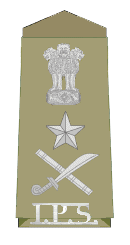 |
Director of the Intelligence Bureau (IB) | 25 | |||
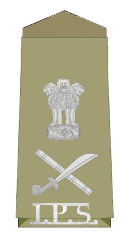 |
Director general of police (Head of State Police Forces) |
| |||
 |
HAG+ Scale (pay level 16) | Director general of police |
|
₹205,400 (US$2,900)—₹224,400 (US$3,100) | |
 |
HAG scale[31] (pay level 15) | Additional director general of police | — |
₹182,200 (US$2,600)—₹224,100 (US$3,100) | |
 |
Senior administrative grade (pay level 14) | Inspector general of police | * Joint commissioner of police in Delhi | — |
₹144,200 (US$2,000)—₹218,200 (US$3,100) |
 |
Super time scale (DIG/Conservator grade) (pay level 13A) | Deputy inspector general of police | * Additional commissioner of police in Delhi | — |
₹131,100 (US$1,800)—₹216,600 (US$3,000) |
 |
Selection grade (pay level 13) | Superintendent of police (selection grade) | Deputy commissioner of police in Delhi. | ₹118,500 (US$1,700)—₹214,100 (US$3,000) | |
 |
Junior administrative grade (pay level 12) | Superintendent of police | Deputy commissioner of police in Delhi. | ₹78,800 (US$1,100)—₹191,500 (US$2,700) | |
 |
Senior time scale (pay level 11) | Additional superintendent of police | Additional deputy commissioner of police in Delhi. | ₹67,700 (US$950)—₹160,000 (US$2,200) | |
 |
Junior time scale (pay level 10) | Deputy Superintendent of Police | Assistant commissioner of police in Delhi. | ₹56,100 (US$790)—₹132,000 (US$1,900) | |
Ranks and insignia
Though the standard uniform colour is Khaki.[32]
The ranks, posts and designations of IPS officers vary from state to state as law and order is a state matter. But generally the following pattern is observed.
Ranks of IPS officers
IPS officers are appointed on the basis of either Civil Service Examination or promoted from the state cadre officers. Vacancy in an IPS cadre are determined on the basis of vacancy on an Superintendent of Police rank. Consequently, there are two level of gradations for SP rank. These are level 11 and 12 as per the Seventh Pay Commission. Resultantly, IPS officers remain on the rank on SP till the 13th year after which they are eligible for being promoted as Senior Superintendent of Police (SSP). ASP rank is the junior most rank on an IPS state cadre. Consequently, fresh recruits to IPS are variously posted as Assistant Superintendent of Police in a supernumerary capacity (only for training purpose for two years and after that for 1 year) till they are formally placed as Superintendent of Police In-Charge of an area (when they get the pay of level 11 and level 12) and as district in charge (when they get the pay of level 12) (only in non-metropolitan districts). When the officers get promoted to the rank of SSP, some of them are posted as the district in-charge of metropolitan districts.[33][34][35][36]
| Insignia |  |
 |
 |
 |
 |
 |
 |
 |
 |
 |
 |
| Rank | Director of Intelligence Bureau (GOI)¹ | Director General of Police² | Additional Director General of Police² | Inspector General of Police | Deputy Inspector General of Police | Senior Superintendent of Police (Selection Grade) | Superintendent of Police | Additional Superintendent of Police | Assistant Superintendent of Police | Assistant Superintendent of Police (Probationary Rank: 2 years of service) | Assistant Superintendent of Police (Probationary Rank: 1 year of service) |
| Abbreviation | DIB | DGP | ADGP | IGP | DIG | SSP | SP | Addl. SP | ASP | ASP | ASP |
| |||||||||||
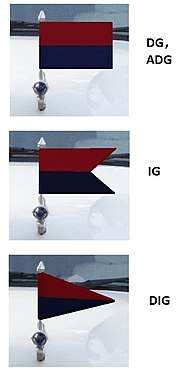
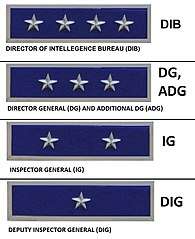
Reforms and major concerns
India's police continue to be governed by a colonial police law passed in 1861. The Indian Constitution makes policing a state subject and therefore the state governments have the responsibility to provide their communities with a police service. However, after independence, most have adopted the 1861 Act without change, while others have passed laws heavily based on the 1861 Act.
Repeated major incidents, (latest of them being 2012 Delhi gang rape) revealed failure of police to uphold the rule of law.[40][41]
The need for reform of police in India has been long recognised. There has been almost 30 years of debate and discussion by government created committees and commissions on the way forward for police reform, but India remains saddled with an outdated and old-fashioned law, while report after report gathers dust on government bookshelves without implementation. Many committees on police reforms have recommended major reforms in the police system coupled with systematic accountability.[42][43]
Corruption and fake encounters
Recently, several IPS officers were arrested and jailed[44][45] in graft and corruption cases[46][47] In recent years, the Appointments Committee of the Cabinet has dismissed few IPS officers for non performance.[48]
Some IPS officers have been convicted of fake encounters.[49][50]
National Police Commission (1977–81)
National Police Commission was the first committee set up by the Indian government to report on policing. The National Police Commission began sitting in 1979, in the context of a post-Emergency India, and produced eight reports, including a Model Police Act, between 1979 and 1981.[51]
Ribeiro Committee (1998–99)
In 1996, two former senior police officers filed a Public Interest Litigation (PIL) in the Supreme Court, asking for the Court to direct governments to implement the recommendations of the National Police Commission. The Supreme Court directed the government to set up a committee to review the Commission's recommendations, and thus the Ribeiro Committee was formed. The Committee, under the leadership of J. F. Ribeiro, a former chief of police, sat over 1998 and 1999, and produced two reports.[51][52]
Padmanabhaiah Committee (2000)
In 2000, the government set up a third committee on police reform, this time under the stewardship of a former union Home Secretary, K. Padmanabhaiah. This Committee released its report in the same year.[51][53]
Malimath Committee Report (2003)
The Malimath Committee Report submitted in March 2003 has very articulately laid down the foundation of a restructured and reoriented police system. The Committee in its report observed that the success of the whole process of Criminal Justice Administration depended completely on the proper functioning of the police organisation especially in the investigation stage. Apart from the investigation of offences, the police also have the duty of maintaining law and order.
Soli Sorabjee Committee (2005)
In 2005, the government put together a group to draft a new police Act for India. It was headed by Soli Sorabjee (former Attorney General). The committee submitted a Model Police Act to the union government in late 2006.[51]
Supreme Court intervention (2006)
In 1996, Prakash Singh (a former chief of Assam Police and Uttar Pradesh Police and subsequently Director General of the Border Security Force) initiated a Public Interest Litigation (PIL) in the Supreme Court of India, asking the court to investigate measures to reform the police forces across India to ensure the proper rule of law and improve security across India. The Supreme Court studied various reports on police reforms. Finally, in 2006, a bench of Justice Y.K. Sabharwal, Justice C.K. Thakker and Justice P.K. Balasubramanyan[54] ordered the state governments to implement several reforms in police force.[55]
Several measures were identified as necessary to professionalise the police in India:
- A mid or high ranking police officer must not be transferred more frequently than every two years.
- The state government cannot ask the police force to hire someone, nor can they choose the Director General of the State Police.
- There must be separate departments and staff for investigation and patrolling,[56] which will include the creation of:
- A State Security Commission, for policies and direction
- A Police Establishment Board, which will decide the selection, promotions and transfers of police officers and other staff
- A Police Complaints Authority, to inquire into allegations of police misconduct.
Follow-up from Supreme Court
In 2006, due to a lack of action by all the state governments,[57] the Supreme Court ordered the state governments to report to it why the reform measures outlined were not implemented.[58] After being questioned in front of the judges of the Supreme Court, the state governments are finally starting to reform the police forces and give them the operational independence they need for fearless and proper law enforcement. Tamil Nadu Police has been in the forefront of application of the new referendum.[59]
Again, in October 2012, a Supreme Court bench of Chief Justice Altamas Kabir and justices Surinder Singh Nijjar and Jasti Chelameswar asked all state governments and Union territories to inform about compliance of its September 2006 judgement. The order was passed when Prakash Singh through his lawyer Prashant Bhushan said that many of the reforms (ordered by the Supreme Court) have yet not been implemented by many state governments.[60]
Women in the Indian Police Service
- In 1975 Kiran Bedi became the First Lady Indian Police Service Officer and was the only woman in a batch of 80 IPS Officers, she joined the AGMUT Cadre.[61]
- In 1975 Jija Madhavan Harisingh became the First Lady Indian Police Service (IPS) Officer from South-India (Karnataka cadre) and she remained in service for 36 years before retirement in 2011 as Director General of Police (DGP).
- In 1992 Asha Sinha a 1982 Batch IPS Officer became the First Woman Commandant in the Paramilitary forces of India when she was posted as Commandant, Central Industrial Security Force in Mazagon Dock Shipbuilders Limited and she remained in service for 34 years before retirement in 2016 as Director General of Police(DGP).
- Kanchan Chaudhary Bhattacharya, the second Lady IPS Officer of India belonging to the 1973 Batch became the first Lady Director General of Police of a State in India when she was appointed DGP of Uttarakhand Police.
- In 2018, an IPS Officer Archana Ramasundaram of 1980 Batch became the first woman to become the director general of police of a Central Armed Police Force as DG, Sashastra Seema Bal.[62]
See also
- National Police Memorial India
- Indian State Police Services
- Law enforcement in India
- Civil Services of India
- All India Service
- Special Duty Allowance (SDA)
- Union Public Service Commission
Notes
- The rank of IGP is ranked and equated with the rank of Brigadier / equivalent rank of the Indian Armed Forced as per Warrant of Precedence – 1937, as per Ministry of Home Affairs' directions contained in Letter No 12/11/99-Pub II dated 26 December 1966. This Warrant of Precedence is compiled from a joint consideration of the existing Central Warrant of Precedence (which is till the rank of Major General) and Warrant of Precedence – 1937, as per Ministry of Home Affairs' directions contained in Letter No 12/11/99-Pub II dated 26 December 1966, the validity of which has been confirmed by Letter No 12/1/2007-Public dated 14 August 2007. The MHA has confirmed in 2007 that the Old Warrant of Precedence shall be taken as a guide to determine ranks below the ones mentioned in the current WoP.
References
- "Data History of Indian Police Service (Official Raj Govt. Page)". Archived from the original on 3 May 2010. Retrieved 26 April 2010.
- "Authorised Cadre Strength of the Indian Police Service (as on 01.01.2016)" (PDF). Ministry of Home Affairs. Archived from the original (PDF) on 28 August 2017. Retrieved 18 September 2017.
- "IPS, IAS and IFS: All India Services (Government of India)" (PDF). Archived from the original (PDF) on 16 April 2009. Retrieved 13 April 2009.
- "IPS officers win battle to head central police forces as Supreme Court rules in their favour". ThePrint. 18 October 2019. Retrieved 18 October 2019.
- "Discussion in Constituent Assembly on role of Indian Administrative". Government of India. Archived from the original on 9 September 2017. Retrieved 18 September 2017.
- "Save the integrity of the civil service". July 2017. Retrieved 18 September 2017.
- H.N. Bali. "One Who Forged India's Steel Frame". Archived from the original on 30 July 2017. Retrieved 18 September 2017.
- Shahidullah, Shahid M. (2012). Comparative Criminal Justice Systems. Burlington, Massachusetts: Jones & Bartlett Learning. ISBN 9781449604257.
- Bhullar, Colonel (Retd) Pritam (19 July 2015). "A worrisome slide in Army's status". Hindustan Times. Retrieved 8 September 2017.
- Alexander, K. (2006). Police Reforms in India: An Analytical Study. New Delhi: Discovery Publishing Group. ISBN 9788183561280.
- "Part XIV of the Constitution of India- Services under the Union and the States – Article 312(2)" (PDF). Ministry of Law and Justice, Government of India. Archived from the original (PDF) on 3 December 2011. Retrieved 18 September 2017.
- Kumar, Manan (29 April 2016). "States reel under huge shortfall of IPS officers". Daily News and Analysis. Retrieved 5 October 2017.
- "908 posts of IPS officers lying vacant". The Economic Times. 20 March 2016. Retrieved 5 October 2017.
- "Duties and Responsibilities of Indian Police Service officers". UPSCguide.com. Archived from the original on 2 January 2010. Retrieved 19 December 2009.
- "Authorised Cadre Strength of the Indian Police Service (as on 01.01.2011)" (PDF). nic.in. 1 January 2011. Archived from the original (PDF) on 12 November 2011. Retrieved 21 July 2011.
- "Indian Police Service (IPS) – Civil List 2017". Ministry of Home Affairs, Government of India. Archived from the original on 24 December 2016. Retrieved 18 September 2017.
- Dutta, Amrita Nayak (21 August 2017). "New cadre Policy which focuses on National Integration of All India". Daily News and Analysis. Retrieved 21 August 2017.
- "New cadre policy for IAS, IPS". The Indian Express. 24 August 2017. Retrieved 24 August 2017.
- Bhaskar, Utpal (24 August 2017). "Govt's proposed cadre policy for IAS, IPS officers draws ire". Live Mint. HT Media Ltd. Retrieved 19 September 2017.
- Shrivastava, Ashwini, ed. (23 August 2017). "Govt finalises new cadre policy for IAS, IPS officers". India Today. Retrieved 10 September 2017.
- "IAS, IPS allocation policy rejigged for 'national integration of bureaucracy'". Hindustan Times. 23 August 2017. Retrieved 10 September 2017.
- "Central government finalises new cadre policy for IAS, IPS officers". Deccan Chronicle. 24 August 2017. Retrieved 10 September 2017.
- "Cadre Allocation Policy for the All India Services-IAS/IPS/IFoS — Reg" (PDF). Department of Personnel and Training, Government of India. 5 September 2017. Retrieved 10 September 2017.
- "Consolidated Deputation Guidelines for All India Services" (PDF). Department of Personnel and Training, Government of India. 28 November 2007. Retrieved 13 August 2017.
- "Old Cadre allocation policy for All India Services – IAS/IPS/IFS" (PDF). Department of Personnel and Training, Government of India. 30 May 1985. Retrieved 13 August 2017.
- Ganihar, N.; Belagali, Dr. H. V. (2009). Indian Administration (Vol. 2) (Educational Philosophy of Dr. Zakir Hussain). Global Vision Publishing House. p. 325. ISBN 9788182202412. Retrieved 4 September 2017.
- "Revised Cadre Allocation Policy w.e.f. CSE-2009, dated 15.06.2011" (PDF). Department of Personnel and Training, Government of India. 15 June 2011. Retrieved 13 August 2017.
- "The Indian Police Service (Pay) Rules, 2016" (PDF). Department of Personnel and Training, Government of India. 23 September 2016. Archived from the original (PDF) on 21 July 2017. Retrieved 18 September 2017.
- "Report of the 7th Central Pay Commission of India" (PDF). Seventh Central Pay Commission, Government of India. Archived from the original (PDF) on 20 November 2015. Retrieved 18 September 2017.
- "The Delhi Police Act, 1978 (Act No. 34 of 1978)". Delhi Police. 27 August 1978. Retrieved 18 September 2017.
- Promotion to various grades – Amendment in the IPS promotion guidelines. Indian Police Service. 19 July 2010
- Loiwal, Amit (3 March 2007). "Why is the colour of the Indian police uniform khaki?". The Times of India. Retrieved 5 October 2017.
- "Police Ranks" (PDF). Maharashtra Police. Archived from the original (PDF) on 15 August 2017. Retrieved 14 August 2017.
- "Governance of Kerala Police". Kerala Police. Retrieved 14 August 2017.
- "Police Ranks and Badges". Odisha Police. Retrieved 15 August 2017.
- "Director, Intelligence Bureau's Insignia Equivalent to Armed Forces Generals". Government of India. Archived from the original on 16 April 2009. Retrieved 27 July 2009.
- "Police Ranks" (PDF). Maharashtra Police. Retrieved 14 August 2017.
- "Governance of Kerala Police". Kerala Police. Retrieved 14 August 2017.
- "Police Ranks and Badges". Odisha Police. Retrieved 15 August 2017.
- "Inept Delhi cops get HC rap". Daily News and Analysis. 21 December 2012. Retrieved 5 October 2017.
- "Two ACPs are suspended". The Hindu. 25 December 2012. Retrieved 5 October 2017.
- "Failure of governance root cause of crimes against women: Verma committee". The Hindu. 23 January 2013. Retrieved 23 January 2013.
- "Read: Highlights of Justice Verma Committee report". CNNIBNLive. 23 January 2013. Retrieved 23 January 2013.
- Parihar, Rohit (17 September 2015). "This IPS officer spent 7 years in jail before he busted biggest bribery case". India Today. Retrieved 5 October 2017.
- "IPS officer gets 13-year jail term for pilfering seized drug". Daily News and Analysis. 11 March 2013. Retrieved 5 October 2017.
- "Corruption case against IPS officer, 5 held by Vigilance Dept". The Hindu. 23 June 2016. Retrieved 5 October 2017.
- Sood, Aman (18 August 2016). "Booked for job fraud, IPS officer on the run". The Tribune. Retrieved 5 October 2017.
- "2 IPS officers 'compulsorily' retired for not performing". The New Indian Express. 17 January 2017. Retrieved 5 October 2017.
- "MHA terminates services of IPS officer connected to Bhojpur fake encounter". The Indian Express. 23 February 2017. Retrieved 5 October 2017.
- "CBI arrests IPS officer in 2004 Ishrat Jahan fake encounter case". The Telegraph. 21 February 2013. Retrieved 5 October 2017.
- "PRAKASH SINGH Case at LIIofIndia.org". Retrieved 12 April 2013.
- "Ribeiro Committee". Retrieved 12 April 2013.
- "Padmanabhaiah Committee". Archived from the original on 6 March 2013. Retrieved 12 April 2013.
- "Prakash Singh Case". Retrieved 12 April 2013.
- Prasad, Devika; Caroline Avanzo (5 November 2006). "Seize the opportunity". The Hindu. Retrieved 5 October 2017.
- Strip, Mobius; Ramesh Ramanathan (7 May 2007). "Sohrabbudin's encounter". Live Mint. HT Media Ltd. Retrieved 7 September 2017.
- "COMPLIANCE WITH SUPREME COURT DIRECTIVES" (PDF). Archived from the original (PDF) on 6 March 2013. Retrieved 12 April 2013.
- "The Supreme Court of India takes the lead on police reform: Prakash Singh vs. Union of India". Archived from the original on 25 September 2009. Retrieved 12 September 2007.
- Das, Sunrat (6 May 2007). "Board to lend ears to transfer woes". Retrieved 18 September 2017.
- "SC asks states to file affidavit on police reforms". Hindustan Times. 16 October 2012. Archived from the original on 17 October 2012. Retrieved 5 October 2017.
- "First woman IPS officer Kiran Bedi seeks voluntary retirement". The Economic Times. 27 November 2007. Retrieved 18 September 2017.
- "First ever woman chief of SSB retires; Rajni Kant Mishra takes charge". Economic Times. 14 July 2018.
Further reading
- History of services of Indian police service, as on 1 July 1966, by Ministry of Home Affairs, India. Published by Govt. of India, 1969.
- The peace keepers: Indian Police Service (IPS), by S. R. Arun, IPS, DGP Uttar Pradesh. Published by Berghahn Books, 2000. ISBN 978-81-7049-107-1.
- The Indian Police Journal (IPJ), by Bureau of police Research and Development, Ministry of Home Affairs. Published by Govt. of India, October–December 2009 Vol.LVI-No.4. ISSN 0537-2429.
- History of services of Indian police service, as on 1 July 1966, by Ministry of Home Affairs, India. Published by Govt. of India, 1969.
External links
| Wikimedia Commons has media related to Indian Police Service. |
- Sardar Vallabhbhai Patel National Police Academy
- "Shortage of IPS officers". Press Information Bureau. Archived from the original on 30 December 2016.
